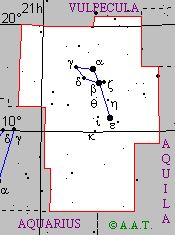 |
 |
| English name | Dolphin | ||||
|---|---|---|---|---|---|
| Major stars | No star of the constellation exceeds the magnitude 3,5. | ||||
| Description | Small constellation between Pegasus and Aquila: its shape remembers a kite. It doesn't contain particularly interesting objects, except gamma Delphini, a double star formed by a yellow component of fourth magnitude and by a yellow-white component of fifth magnitude. | ||||
| Mythology and history | According to Eratostenes' version, the constellation represents the messenger of the sea god, Poseidon. Poseidon fell in love with the nymph Anphitrite, but he wasn't able to find the way to convince her to marry him: it was the dolphin, with his natural gentleness, which succeeded in combining the wedding. To thank him, Poseidon gave him a place among the stars. According to Hyginus' version, instead, the constellation represents the dolphin that saved poet Arion's life. While he was making a voyage, Arion, who was a lyre skilled player, was attacked by the sailors, who wanted to kill him and to steal his money: when they surrounded him with the drawn swords, Arion asked and got to may sing for the last time. His song attracted a flock of dolphins and the poet, moved by the desperation, threw himself in the sea: one of the dolphins take him on its back and brought him save and sound to shore. Apollo, god of the arts, put the dolphin among the constellations, together with Arion's instrument, Lyra. Alpha and beta Delphini have two curious names: Sualocin and Rotanev. Such names were attributed in 1814 by the Italian astronomer Niccolò Cacciatore: if you read them backwards, they become Nicolaus Venator, that is the Latin translation of Niccolò Cacciatore. He is the only man who succeeded in giving his own name to stars. |
||||
 Back to constellations page.
Back to constellations page.